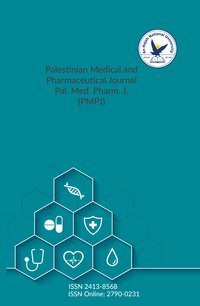The mucinous ovarian cancer: classification and clinical use of cancer biomarkers for diagnosis
Authors:
Article info
2018-07-01
2018-08-29
55 - 58
Keywords
- Jordan
- Women
- CEA
- serology
- Ca125
- screening
- Mucinous ovarian cancer (MOC)
Abstract
The aims of the study were to examine the prevalence of positive mucinous ovarian carcinoma (MOC) at different stages as well as to investigate the age at diagnosis and histological type, and to assess the correlation between the carcinoembryonic antigen/ cancer antigen 125 (CEA/CA 125) tests and the diagnosis of ovarian cancers retrospectively, to promote the prognosis and patient’s health outcome. Descriptive a cross-sectional correlational design was used to examine the prevalence of positive ovarian cancer over a period of seven years of follow-up between 2010 and 2016. All study analysis was performed using SPSS version 22. P<0.05 was taken to indicate a statistically significant value. We found that about 70% of cases showed elevation of CEA marker and about 95% of them showed elevation of Ca125. The age-specific incidence rate increased greatly in women aged 50 years or older. The majority of the patients had stage III or IV disease. Our study results can be used as a detection method of possible new ovarian cancer cases in an early stage and would provide a quick non-invasive screening method for women with strong risk factors such as old age, smoking, family history, history of other tumors and obesity.
Al-Tarawneh, B., & Hamdan, O. (2018). The mucinous ovarian cancer: classification and clinical use of cancer biomarkers for diagnosis. Palestinian Medical and Pharmaceutical Journal, 3(2), 55–58. https://doi.org/10.59049/2790-0231.1043
[1]B. Al-Tarawneh and O. Hamdan, “The mucinous ovarian cancer: classification and clinical use of cancer biomarkers for diagnosis,” Palestinian Medical and Pharmaceutical Journal, vol. 3, no. 2, pp. 55–58, Dec. 2018, doi: 10.59049/2790-0231.1043.
Al-Tarawneh, Bushra, and Omar Hamdan. “The Mucinous Ovarian Cancer: Classification and Clinical Use of Cancer Biomarkers for Diagnosis.” Palestinian Medical and Pharmaceutical Journal, vol. 3, no. 2, Dec. 2018, pp. 55–58. Crossref, https://doi.org/10.59049/2790-0231.1043.
1.Al-Tarawneh B, Hamdan O. The mucinous ovarian cancer: classification and clinical use of cancer biomarkers for diagnosis. Palestinian Medical and Pharmaceutical Journal [Internet]. 2018 Dec;3(2):55–8. Available from: http://dx.doi.org/10.59049/2790-0231.1043
Al-Tarawneh, Bushra, and Omar Hamdan. “The Mucinous Ovarian Cancer: Classification and Clinical Use of Cancer Biomarkers for Diagnosis.” Palestinian Medical and Pharmaceutical Journal 3, no. 2 (December 2018): 55–58. https://doi.org/10.59049/2790-0231.1043.
The mucinous ovarian cancer: classification and clinical use of cancer biomarkers for diagnosis
المؤلفون:
معلومات المقال
2018-07-01
2018-08-29
55 - 58
الكلمات الإفتتاحية
- Jordan
- Women
- CEA
- serology
- Ca125
- screening
- Mucinous ovarian cancer (MOC)
الملخص
The aims of the study were to examine the prevalence of positive mucinous ovarian carcinoma (MOC) at different stages as well as to investigate the age at diagnosis and histological type, and to assess the correlation between the carcinoembryonic antigen/ cancer antigen 125 (CEA/CA 125) tests and the diagnosis of ovarian cancers retrospectively, to promote the prognosis and patient’s health outcome. Descriptive a cross-sectional correlational design was used to examine the prevalence of positive ovarian cancer over a period of seven years of follow-up between 2010 and 2016. All study analysis was performed using SPSS version 22. P<0.05 was taken to indicate a statistically significant value. We found that about 70% of cases showed elevation of CEA marker and about 95% of them showed elevation of Ca125. The age-specific incidence rate increased greatly in women aged 50 years or older. The majority of the patients had stage III or IV disease. Our study results can be used as a detection method of possible new ovarian cancer cases in an early stage and would provide a quick non-invasive screening method for women with strong risk factors such as old age, smoking, family history, history of other tumors and obesity.
Al-Tarawneh, B., & Hamdan, O. (2018). The mucinous ovarian cancer: classification and clinical use of cancer biomarkers for diagnosis. Palestinian Medical and Pharmaceutical Journal, 3(2), 55–58. https://doi.org/10.59049/2790-0231.1043
[1]B. Al-Tarawneh and O. Hamdan, “The mucinous ovarian cancer: classification and clinical use of cancer biomarkers for diagnosis,” Palestinian Medical and Pharmaceutical Journal, vol. 3, no. 2, pp. 55–58, Dec. 2018, doi: 10.59049/2790-0231.1043.
Al-Tarawneh, Bushra, and Omar Hamdan. “The Mucinous Ovarian Cancer: Classification and Clinical Use of Cancer Biomarkers for Diagnosis.” Palestinian Medical and Pharmaceutical Journal, vol. 3, no. 2, Dec. 2018, pp. 55–58. Crossref, https://doi.org/10.59049/2790-0231.1043.
1.Al-Tarawneh B, Hamdan O. The mucinous ovarian cancer: classification and clinical use of cancer biomarkers for diagnosis. Palestinian Medical and Pharmaceutical Journal [Internet]. 2018 Dec;3(2):55–8. Available from: http://dx.doi.org/10.59049/2790-0231.1043
Al-Tarawneh, Bushra, and Omar Hamdan. “The Mucinous Ovarian Cancer: Classification and Clinical Use of Cancer Biomarkers for Diagnosis.” Palestinian Medical and Pharmaceutical Journal 3, no. 2 (December 2018): 55–58. https://doi.org/10.59049/2790-0231.1043.

Since 2022
Cite Score (Scopus): 0.8
Time to First Decision: 3 Days
Submission to Acceptance: 45 Days
Acceptance to Publication: 64 Days
Acceptance Rate: 17%
Why should you
Publish With Us?
An-Najah National University
Nablus, Palestine
Nablus, Palestine
- P.O. Box
- 7, 707
- Fax
- (970)(9)2345982
- Tel.
- (970)(9)2345560
- (970)(9)2345113/5/6/7-Ext. 2628
- [email protected]
- EIC
- Prof. Waleed Sweileh
The Palestinian Medical and Pharmaceutical Journal (Pal. Med. Pharm. J.) © 2024 by An-Najah University, Nablus, Palestine is licensed under CC BY-NC 4.0
News and Views
